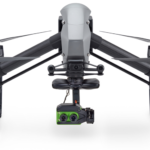 The following is a guest post by Blue Label Labs Editor Rae Steinbach.
The following is a guest post by Blue Label Labs Editor Rae Steinbach.
Unmanned Aerial Vehicles, commonly known as drones, have become a big business over the last few years, and the market is still continuing to grow. Business Insider predicts sales to grow beyond $12 billion in the year 2021. While drones already have a number of applications, a businesses can hire a programmer who can apply Augmented Reality to the technology in order to expand the possibilities.
When combined with AR, drones can be equipped with an advanced range of capabilities that will open up new opportunities for recreation, business, and government. This post will detail some of the ways AR is already changing the way drones are used.
Games
Gaming is one of the most obvious applications for Augmented Reality drones. One example of this is the Mission Drone from Air Hogs Connect. With the Mission Drone and the linked app, users can pilot a physical UAV through virtual AR missions in . The app simulates a city through which the user can user can navigate the drone to complete various rescue missions.
Law Enforcement
Drones have the potential to significantly benefit law enforcement, and some police departments are already deploying drones in their fight against crime. Drones could be used for all manner of things, like surveillance, crowd monitoring, accident reconstruction, patrol, suspect apprehension, and search and rescue missions. UAVs could also be used to provide conditional awareness for police that are dealing with things like active shooter situations and hostage rescue.
Disaster Response
Some cities are starting to use drones as a tool for disaster response. During some recent disasters, drones were deployed to help find people that were in need of assistance. They have also been used to create disaster maps and assess damage after events like hurricanes and earthquakes. By using AR to overlay important data, drones could increase the effectiveness of and improve safety for first responders.
Engineering
Engineers are already employing drones for a number of different applications. By adding AR technology, drones can be used to make several engineering tasks easier and even improve the results of some processes.
Surveyors are using drones to assist in evaluating land, and with AR, they could superimpose valuable geographic data over the images that come from the drones.
Engineers could also use drones to inspect bridges and levees. Construction engineers would be able to use drones to create 3D models of a project before the ground is even broken.
Firefighting
In recent years, drones have been used at the scene of some fires. In 2017, firefighters in Los Angeles deployed drones to help fight wildfires, and in London, firefighters used drones to help survey the Grenfell Tower fire.
Using drones, infrared cameras, and AR technology, technology can be used to create heat maps that can help firefighters locate hotspots. These can also help locate people that need rescue, and can survey a building to find where flames are spreading. This ensures that the structure is still safe for firefighters to enter.
We are already starting to see some of the ways in which AR can be applied to drones to make them more useful, but this is just the beginning. As AR developers experiment further with drones, they will find new applications for AR-enhanced UAVs.
 Rae works as a Freelance Editor for Blue Label Labs, a mobile, tablet, watch, TV and AR/VR app design, development and marketing agency. Rae is graduate of Tufts University with a combined International Relations and Chinese degree. After spending time living and working abroad in China, she returned to NYC to pursue her career and continue curating quality content.
Rae works as a Freelance Editor for Blue Label Labs, a mobile, tablet, watch, TV and AR/VR app design, development and marketing agency. Rae is graduate of Tufts University with a combined International Relations and Chinese degree. After spending time living and working abroad in China, she returned to NYC to pursue her career and continue curating quality content.

Miriam McNabb is the Editor-in-Chief of DRONELIFE and CEO of JobForDrones, a professional drone services marketplace, and a fascinated observer of the emerging drone industry and the regulatory environment for drones. Miriam has penned over 3,000 articles focused on the commercial drone space and is an international speaker and recognized figure in the industry. Miriam has a degree from the University of Chicago and over 20 years of experience in high tech sales and marketing for new technologies.
For drone industry consulting or writing, Email Miriam.
TWITTER:@spaldingbarker
Subscribe to DroneLife here.







[…] Source […]